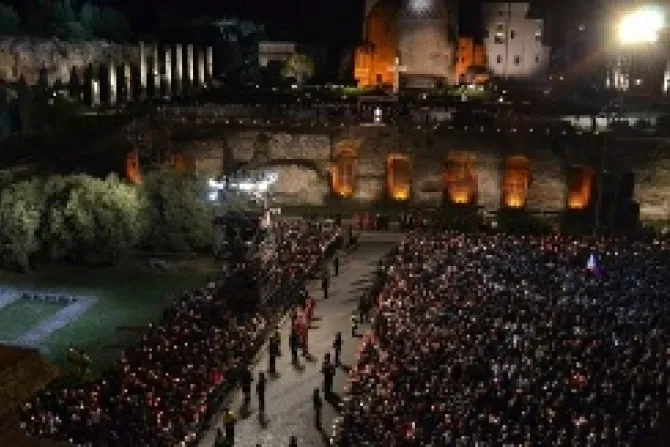Rome, Italy, Apr 18, 2014 / 13:29 pm
Following his celebration of the liturgy commemorating the Lord's Passion, Pope Francis led pilgrims in the traditional prayer of the Stations of the Cross, which was held inside of the Coliseum in Rome.
"I know Jesus guides us from the Cross to the resurrection," Pope Francis said during his brief comments at the end of the meditations, adding that he "teaches us that evil does not have the final word, but love, mercy."
"Oh Christ, help us to exclaim anew: 'Yesterday I was crucified with Christ, today I am resurrected with him; yesterday I was dead with Christ, today I am alive with him; yesterday I was buried with him, today I am resurrected with him,'" the Pope reflected.
"All together, we remember the sick," the pontiff exhorted the crowd in his concluding remarks, "we remember all those abandoned," and "we find in the trial of the Cross, a force of hope, of the hope of the resurrection and of the love of God."
Beginning at 9 p.m. On Friday, the meditations for the prayer – which were written by Archbishop Giancarlo Bregantin who oversees the diocese of Campobasso-Boiano in Italy – reflected on the theme "In the suffering face of man is the profile of Christ."
During an April 14 interview with CNA, the archbishop said that he referred to Pope Francis' example as well as the pontiff's first apostolic exhortation "Evangelii Gaudium" when writing the meditations.
"The true Way of the Cross is not what I have written, but what Pope Francis has done," he said. "It is he who has made the Way of the Cross. I have only given words to what he writes and does. I am only a spokesman."
"Evangelii Gaudium," he observed is an "intense document" because in it the Pope "analyzes with clarity and gives very accurate and intense, real and courageous answers. Prophetic."
Speaking of this year's stations, the archbishop explained that this year they have a special flavor because they represent "The Passion of Jesus which illuminates my passion."
"It's not a sermon, a story or an exercise" he stated, clarifying that it is "immersing yourself in our pain, searching in the pain of Christ for the light that only Jesus can give to us," and adding that "the 14 stations walk through all of the dramas of man from all times."
"There is no pain in the world that is not fruitful. You never suffer in vain," Archbishop Bregantin emphasized, reflecting that "to understand it each one of us has to know that he has before him the face of Jesus."
"Because with these eyes, light and heart, it is possible to encounter in all parts of the world and in every pain and heart, a great hope."
A centuries-old devotion, the Stations of the Cross originally began as a spiritual pilgrimage to the places marking the events of Christ's Passion and death for those who were unable to travel to the Holy Land in person, as well as for those who wished to relive their experience of going and those preparing to make the journey.
The practice of placing the "stations" of the Cross inside of churches, as well as the number of stations, 14, can be traced back at least to the 18th century.
Persons who carried the Cross during the prayer consisted of varying ages, backgrounds and states of life in the Church, and were all selected in order to illustrate the theme of suffering in Archbishop Bregantin's meditations.
During the prayer, large television screens were set up in the nearby Circo Massimo as well as on the via dei fori imperiali, which runs past the Colosseum, were put in place for participants who were unable to view what was happening inside.
Marta Jimenez contributed to this piece.



